
Swimming pools provide people with a great way to escape the hot summer sun, and knowing how to shock a pool is one of the most important things pool caretakers or owners can do to keep the water safe for swimmers. It’s also one of the most basic maintenance tasks. The term “shocking a pool” describes the quickness with which certain forms of chlorine shocks the water to make it clear and clean, with the added benefit of ridding the water of contaminants like algae, bacteria, and chloramines.
Why Shocking a Pool is So Important
Chlorine shock comes in either liquid or granular form, though liquid shock tends to be used for larger commercial swimming pools, as found at hotels or health clubs, while granular shock tends to be the choice for residential pools. Shocking a pool should be done in conjunction with slow-dissolving chlorine tablets, which help maintain sufficient chlorination levels.
The purpose of shocking a pool is to increase free chlorine levels in the water rapidly until it reaches about ten times the combined chlorine levels. Once the chlorination levels reach this stage, the free chlorine largely eliminates contaminants, making the pool water safe for swimmers. Shocking a pool should raise free chlorine levels to 5-10 parts per million (ppm), which helps break up the combined chlorine.
Most local and state health departments limit the amount of combined chlorine to levels of 0.4 ppm or lower in public pools. As a type of combined chlorine, chloramines form in pool water, releasing gas into the air just above the water. This off-gassing can build up, particularly with indoor swimming pools, which can result in negative health effects to anyone exposed. Health issues include irritation to skin, eyes, nose, throat and lungs, potentially causing coughing, shortness of breath or even build-up of fluid within the lungs.
What is the Best Pool Shock?
The best pool shock to use depends on the type of pool and its surrounding environment.
These are the most-used chemicals for shocking a pool:
- Calcium hypochlorite, often referred to as cal-hypo, offers a way to quickly boost free chlorine levels without impacting cyanuric acid (CYA) levels, which keeps chlorine from degrading in sunlight. This is the best pool shock treatment for pools that use chlorine tablets.
- Sodium dichloro-s-triazinetrione – called di-chlor for short – also acts fast to boost free chlorine levels in pool water. It is treated with CYA, which protects chemicals from evaporating from pools in hot, sunny weather. It offers the best pool shock treatment for swimming pools that use liquid chlorine as well as for saltwater pools.
- Potassium monopersulfate, or MPS, oxidizes organic impurities in the water to prevent combined chlorine from forming, though it does not totally eliminate it, and is used mainly as a preventative measure. Also known as chlorine-free or chlor-free due to the fact it uses no chlorine when shocking a pool, MPS works best for indoor swimming pools and hot tubs.
How to Shock a Pool
Though one of the easiest parts of pool maintenance, wearing protective gear like goggles and gloves is recommended when shocking a pool.
Here’s how to shock a pool in five simple steps:
- Test the water with a water testing kit or strips to balance pH levels.
- Mix pool shock with pool water in a large (5-gallon) bucket.
- Circulate pool water through the filtration system by turning on the pump, then pour the bucket with the shock around the pool’s edges.
- Wait for free chlorine levels to drop, which normally takes about six hours, before testing the water again, as water containing too much free chlorine is unhealthy.
- Swim in the pool once free chlorine levels reach 1-3 ppm, at which point the water will be clean, clear, and safe.
The best pool shocking techniques just require a bit of common sense.
When to Administer Chlorine Shock
During peak swimming season, it’s best to shock a pool on a weekly basis. When the weather becomes exceptionally hot and sunny, shocking a pool should occur more regularly. The number of pool users also plays a part in when to use chlorine shock.
Generally, shocking a pool should occur when:
- A pool has seen significant use.
- Algae begin growing in the pool.
- Combined chlorine levels go over 0.5.
- Free chlorine levels drop to zero.
- Once the swimming season has ended, in order to disinfect the water.
- Prior to opening a pool for the season to balance the water’s chemistry.
Excessive rain can also throw off a swimming pool’s pH, along with adding detritus like algae spores, dust, pollen, and other pollutants to the water. Cloudy or green water are good indicators of when chlorine levels drop, and regular testing can confirm this.
Best Pool Shocking Times
The best time for shocking a pool is after the swimming is done, and during a period when no one will be swimming. This normally means shocking a pool in the evening, after the hottest part of the day has passed and ultraviolet rays are less intense, particularly when done after dusk. Swimming too soon after shocking a pool can also irritate eyes and skin.
Halogen Supply is a trusted distributor of commercial and residential pool and spa supplies for more than 70 years. See our full selection of swimming pool chemicals for pool shocking and maintenance!
